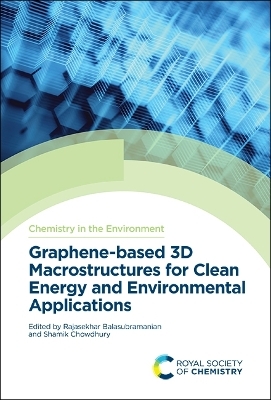
Graphene-based 3D Macrostructures for Clean Energy and Environmental Applications
Royal Society of Chemistry (Verlag)
978-1-83916-001-1 (ISBN)
With escalating global population, increased consumption of fossil fuels, spiralling energy demand, rapid environmental degradation and global climate change, energy and environmental issues are receiving considerable attention worldwide from the purview of sustainable development. In order to address these complex and interlinked challenges, the development of new materials for affordable green energy technologies (batteries, supercapacitors, fuel cells and solar cells) and environmental remediation methods (adsorption, photocatalysis, separation, and sensing) is essential. Three-dimensional graphene-based macrostructures (3D GBMs) are of great interest in these applications given their large surface area and adaptable surface chemistry.
Graphene-based 3D Macrostructures for Clean Energy and Environmental Applications provides a critical and comprehensive account of the recent advances in the development and potential applications of high performance 3D GBMs for tackling global energy and environmental issues in a sustainable manner. Particular attention is paid to the fabrication schemes, modulation of physiochemical properties, and their integration into practical devices, and the roles of surface chemistry and pore morphology, as well as their interplay, on the overall performance of 3D GBMs are examined.
With contributions from authors around the world this book is a useful resource for both environmental scientists interested in sustainable energy and remediation solutions and materials scientists interested in applications for 3D GMBs.
Dr Rajasekhar Balasubramanian is a Full Professor in the Department of Civil and Environmental Engineering at the National University of Singapore, Singapore. He received his PhD from the University of Miami, USA in 1991 and worked at Brookhaven National Laboratory, New York and at the New York State Department of Health, Albany as a research scientist prior to joining NUS as a faculty. His interests range across: Air Quality, Climate Change, Aerosol Science & Technology, Environmental & Health Risk Assessment, Water Quality, and Sustainable Development. Dr Shamik Chowdhury is currently an Assistant Professor in the School of Environmental Science and Engineering at the Indian Institute of Technology Kharagpur, India. He obtained his B.Tech. (2009) from the West Bengal University of Technology (India) and M.Tech. (Gold Medalist) (2011) from the National Institute of Technology Durgapur (India), both in Biotechnology. He then earned his Ph.D. (2017) in Environmental Engineering from the National University of Singapore. His current research activities focus on the design and development of advanced functional materials, with an emphasis on graphene-based materials, for sustainable energy applications and climate change mitigation.
Engineering the Architecture of 3D Graphene-based Macrostructures;
Structure–Property Relationships in 3D Graphene-based Macrostructures;
Flexible 3D Graphene-based Electrodes for Ultrahigh Performance Lithium Ion Batteries;
3D Graphene-based Materials for Enhancing the Energy Density of Sodium Ion Batteries;
Ultrafast Charging Supercapacitors Based on 3D Macrostructures of Graphene and Graphene Oxide;
3D GBM-supported Transition Metal Oxide Nanocatalysts and Heteroatom-doped 3D Graphene Electrocatalysts for Potential Application in Fuel Cells;
3D Graphene-based Scaffolds with High Conductivity and Biocompatibility for Applications in Microbial Fuel Cells;
Highly Efficient Dye-sensitized Solar Cells with Integrated 3D Graphene-based Materials;
Fuelling the Hydrogen Economy with 3D Graphene-based Macroscopic Assemblies;
Harvesting Solar Energy by 3D Graphene-based Macroarchitectures;
3D Graphene-based Macrostructures as Superabsorbents for Oils and Organic Solvents;
Fast and Efficient Removal of Existing and Emerging Environmental Contaminants by 3D Graphene-based Adsorbents;
Freestanding Photocatalytic Materials Based on 3D Graphene for Degradation of Organic Pollutants;
3D Graphene-based Macroassemblies for On-site Detection of Environmental Contaminants;
Graphene-based Macroassemblies as Highly Efficient and Selective Adsorbents for Postcombustion CO2 Capture;
Artificial Photosynthesis by 3D Graphene-based Composite Photocatalysts;
| Erscheinungsdatum | 08.04.2021 |
|---|---|
| Reihe/Serie | Chemistry in the Environment ; Volume 1 |
| Verlagsort | Cambridge |
| Sprache | englisch |
| Maße | 156 x 234 mm |
| Gewicht | 851 g |
| Themenwelt | Technik ► Elektrotechnik / Energietechnik |
| Technik ► Umwelttechnik / Biotechnologie | |
| ISBN-10 | 1-83916-001-2 / 1839160012 |
| ISBN-13 | 978-1-83916-001-1 / 9781839160011 |
| Zustand | Neuware |
| Haben Sie eine Frage zum Produkt? |
aus dem Bereich


